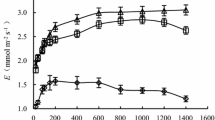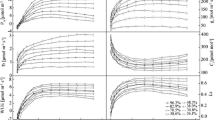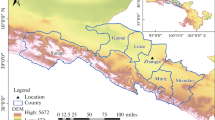Abstract
Photosynthesis is a biological process most affected by water deficit. Plants have various photosynthetic mechanisms that are matched to specific climatic zones. We studied the photosynthetic plasticity of C3 plants at water deficit using ecotypes of Marrubium vulgare L. from high (2,200 m) and low (1,100 m) elevation sites in the Mishou-Dagh Mountains of Iran. Under experimental drought, high-altitude plants showed more tolerance to water stress based on most of the parameters studied as compared to the low-altitude plants. Increased tolerance in high-altitude plants was achieved by lower levels of daytime stomatal conductance (g s) and reduced damaging effect on maximal quantum yield of photosystem II (PSII) (F v /F m ) coupled with higher levels of carotenoids and non-photochemical quenching (NPQ). High-altitude plants exhibited higher water use efficiency (WUE) than that in low-altitude plants depending on the presence of thick leaves and the reduced daytime stomatal conductance. Additionally, we have studied the oscillation in H+ content and diel gas exchange patterns to determine the occurrence of C3 or weak CAM (Crassulacean acid metabolism) in M. vulgare through 15 days drought stress. Under water-stressed conditions, low-altitude plants exhibited stomatal conductance and acid fluctuations characteristic of C3 photosynthesis, though high-altitude plants exhibited more pronounced increases in nocturnal acidity and phosphoenolpyruvate carboxylase (PEPC) activity, suggesting photosynthetic flexibility. These results indicated that the regulation of carotenoids, NPQ, stomatal conductance and diel patterns of CO2 exchange presented the larger differences among studied plants at different altitudes and seem to be the protecting mechanisms controlling the photosynthetic performance of M. vulgare plants under drought conditions.





Similar content being viewed by others
References
Ashraf M, Harris PJC (2013) Photosynthesis under stressful environments: an overview. Photosynthetica 51:163–190
Azzabi G, Pinnola A, Betterle N, Bassi R, Alboresi A (2012) Enhancement of non-photochemical quenching in the Bryophyte physcomitrella patens during acclimation to salt and osmotic stress. Plant Cell Physiol 53:1815–1825
Baker NR, Rosenqvist E (2004) Applications of chlorophyll fluorescence can improve crop production strategies: an examination of future possibilities. J Exp Bot 55:1607–1621
Borland AM, Tecsi LI, Leegood RC, Walker RP (1998) Inducibility of crassulacean acid metabolism (CAM) in Clusia species: physiological/biochemical characterization and intercellular localization of carboxylation and decarboxylation processes in three species which exhibit different degrees of CAM. Planta 205:342–351
Borland AM, Zambrano AB, Ceusters J, Shorrock K (2011) The photosynthetic plasticity of crassulacean acid metabolism: an evolutionary innovation for sustainable productivity in a changing world. New Phytol 191:619–633
Borland AM, Hartwell J, Weston DJ, Schlauch KA, Tschaplinski TJ, Tuskan GA, Yang X, Cushman JC (2014) Engineering crassulacean acid metabolism to improve water-use efficiency. Trends Plant Sci 19:327–338
Brodribb TJ, Jordan GJ, Carpenter RJ (2013) Unified changes in cell size permit coordinated leaf evolution. New Phytol 199:559–570
Cazzonelli CI, Pogson BJ (2010) Source to sink: regulation of carotenoid biosynthesis in plants. Trends Plant Sci 15:266–274
Cushman JC, Borland AM (2002) Induction of crassulacean acid metabolism by water limitation. Plant Cell Environ 25:295–310
Cushman JC, Agarie S, Albion RL, Elliot SM, Taybi T, Borland AM (2008) Isolation and characterization of mutants of ice plant, Mesembryanthemum crystallinum, deficient in crassulacean acid metabolism. Plant Physiol 147:228–238
de Bianchi S, Ballottari M, Dall’Osto L, Bassi R (2010) Regulation of plant light harvesting by thermal dissipation of excess energy. Biochem Soc Trans 38:651–660
Din J, Khan SU, Ali I, Gurmani AR (2011) Physiological and agronomic response of canola varieties to drought stress. J Anim Plant Sci 21:78–82
Ding M, Hou P, Shen X (2010) Salt-induced expression of genes related to Na+/K+ and ROS homeostasis in leaves of salt-resistant and salt-sensitive poplar species. Plant Mol Biol 73:251–269
Flanagan LB, Farquhar GD (2014) Variation in the carbon and oxygen isotope composition of plant biomass and its relationship to water-use efficiency at the leaf-and ecosystem-scales in a northern Great Plains grassland. Plant Cell Environ 37:425–438
Garcia-Moya E, Romero-Manzanares A, Nobel PS (2011) Highlights for Agave productivity. Glob Change Biol Bioenergy 3:4–14
Gimenez-Benavides L, Escudero A, Iriondo JM (2008) What shapes the altitudinal range of a high mountain Mediterranean plant? Recruitment probabilities from ovule to seedling stage. Ecography 31:731–740
Goh CJ, Arditti J, Avadhani PN (1983) Carbon fixation in orchid aerial roots. New Phytol 95:367–374
Groenhof AC, Bryant JA, Etherington JR (1988) Photosynthetic changes in the inducible CAM plant Sedum telephium L. following the imposition of water stress. II. Changes in the activity of phosphoenolpyruvate carboxylase. Ann Bot 62:187–192
Habibi G (2014) Hydrogen peroxide (H2O2) generation, scavenging and signaling in plants. In: Ahmad P (ed) Oxidative damage to plants: antioxidant networks and signaling. Elsevier, USA, pp 557–574
Habibi G, Hajiboland R (2012) Comparison of photosynthesis and antioxidative protection in Sedum album and Sedum stoloniferum (Crassulaceae) under water stress. Photosynthetica 50:508–518
Herrera A, Ballestrini C, Montes E (2015) What is the potential for dark CO2 fixation in the facultative crassulacean acid metabolism species Talinum triangulare? J Plant Physiol 174:55–61
Holtum JAM, Winter K, Weeks MA, Sexton TR (2007) Crassulacean acid metabolism of the ZZ plant, Zamioculcas zamiifolia (Araceae). Am J Bot 94:1670–1676
Huang HY, Zhang Q, Zhao LP, Feng JN, Peng CL (2010) Does lutein play a key role in the protection of photosynthetic apparatus in Arabidopsis under severe oxidative stress? Pak J Bot 42:2765–2774
Jahns P, Holzwarth AR (2012) The role of the xanthophyll cycle and of lutein in photoprotection of photosystem II. Biochim Biophys Acta 1817:182–193
Kofidis G, Bosabalidis AM, Moustakas M (2003) Contemporary seasonal and altitudinal variations of leaf structural features in Oregano (Origanum vulgare L.). Ann Bot 92:635–645
Krall JP, Edwards GE (1992) Relationship between photosystem II activity and CO2 fixation in leaves. Physiol Plant 86:180–187
Lara MV, Disante KB, Podesta FE, Andreo C, Drincovich MF (2003) Induction of a crassulacean acid like metabolism in the C4 succulent plant, Portulaca oleracea L.: physiological and morphological changes are accompanied by specific modifications in phosphoenolpyruvate carboxylase. Photosynth Res 77:241–254
Lichtenthaler HK, Wellburn AR (1985) Determination of total carotenoids and chlorophylls a and b of leaf in dfferent solvents. Biochem Soc Trans 11:591–592
Lippai A, Smith PA, Price TV, Weiss J, Lloyd CJ (1996) Effects of temperature and water potential on germination of horehound (Marrubium vulgare) seeds from two Australian localities. Weed Sci 44:91–99
Miller G, Suzuki N, Ciftci-Yilmaz S, Mittler R (2010) Reactive oxygen species homeostasis and signaling during drought and salinity stresses. Plant Cell Environ 33:453–467
Motomura H, Yukawa T, Ueno O, Kagawa A (2008) The occurence of crassulacean acid metabolism in Cymbidium (Orchidaceae) and its ecological and evolutionary implications. J Plant Res 121:163–177
Murchie EH, Niyogi KK (2011) Manipulation of photoprotection to improve plant photosynthesis. Plant Physiol 155:86–92
Nelson EA, Sage TL, Sage RF (2005) Functional leaf anatomy of plants with crassulacean acid metabolism. Funct Plant Biol 32:409–419
Nimmo HG (2000) The regulation of phosphoenolpyruvate carboxylase in CAM plants. Trends Plant Sci 5:75–80
Owen N, Griffiths H (2013) A system dynamics model integrating physiology and biochemical regulation predicts extent of crassulacean acid metabolism (CAM) phases. New Phytol 200:1116–1131
Pan J, Lin S, Woodbury NW (2012) Bacteriochlorophyll excited state quenching pathways in bacterial reaction centers with the primary donor oxidized. J Phys Chem B 116:2014–2022
Pugnaire FI, Haase P, Puigdefabregas J (1996) Facilitation between higher plant species in a semiarid environment. Ecology 77:1420–1426
Ross RIC, Agren JA, Pannell JR (2012) Exogenous selection shapes germination behaviour and seedling traits of populations at different altitudes in a Senecio hybrid zone. Ann Bot 110:1439–1447
Sade N, Alem G, Moshelion M (2012) Risk-taking plants. Anisohydric behavior as a stress-resistance trait. Plant Signal Behav 7:1–4
Sausen TL, Rosa LMG (2010) Growth and carbon assimilation limitations in Ricinus communis (Euphorbiaceae) under soil water stress conditions. Acta Bot Bras 24:648–654
Silvera K, Santiago LS, Winter K (2005) Distribution of crassulacean acid metabolism in orchids of Panama: evidence of selection for weak and strong modes. Funct Plant Biol 32:397–407
Taiz L, Zeiger E (2010) Plant physiology, 5th edn. Sinauer Associates, Sunderland
Ting IP, Sipes D (1985) Metabolic modifications of crassulacean acid metabolism in CAM-idling and CAM-cycling. In: Luden PW, Burris JE (eds) Night fixation and CO2 Metabolism. Elsevier, Amsterdam, pp 371–378
van Heerden PDR, Swanepoel JW, Krüger GHJ (2007) Modulation of photosynthesis by drought in two desert scrub species exhibiting C3-mode CO2 assimilation. Environ Exp Bot 61:124–136
Vaz J, Sharma PK (2011) Relationship between xanthophy cycle and non-photochemical quenching in rice (Oryza sativa L.) plants in response to light stress. Indian J Exp Bot 49:60–67
Wahbi S, Wakrim R, Aganchich B, Serraj R (2005) Effects of partial rootzone drying (PRD) on adult olive tree (Olea europaea) in field conditions under arid climate. I. Physiological and agronomic responses. Agric Ecosyst Environ 106:289–301
Winter K, Garcia M, Holtum JAM (2011) Drought-stress-induced up-regulation of CAM in seedlings of a tropical cactus, Opuntia elatior, operating predominantly in the C3 mode. J Exp Bot 31:1–6
Zambrano VAB, Lawson T, Olmos E, Fernández-García N, Borland AM (2014) Leaf anatomical traits which accommodate the facultative engagement of crassulacean acid metabolism in tropical trees of the genus Clusia. J Exp Bot 65:3513–3523
Acknowledgments
We thank Dr. R. Hajiboland, University of Tabriz for providing the gas exchange system and assistance in determination of PEPC activity.
Author information
Authors and Affiliations
Corresponding author
Rights and permissions
About this article
Cite this article
Habibi, G., Ajory, N. The effect of drought on photosynthetic plasticity in Marrubium vulgare plants growing at low and high altitudes. J Plant Res 128, 987–994 (2015). https://doi.org/10.1007/s10265-015-0748-1
Received:
Accepted:
Published:
Issue Date:
DOI: https://doi.org/10.1007/s10265-015-0748-1




